Article Summary:
Most organizations aren’t aligned. This reduces performance dramatically and often causes frustration and dysfunction. Here we show leaders how to align their organization or team. We include an Alignment Scorecard to assess your current levels of alignment.
+++
In our experience, most organizations aren’t aligned. If they’re not aligned, they’re underperforming. And perhaps dysfunctional.
Alignment is a collaborative process providing cohesion, clarity, and focus to get everyone moving in the same direction.
To assess the extent to which your organization is aligned, use our Alignment Scorecard.

Alignment Scorecard
When organizations aren’t aligned, it can reduce performance dramatically and cause frustration and dysfunction. With this Alignment Scorecard, you can assess your organization’s level of alignment and make plans for improving it.
What Are Aligned Organizations?
In aligned organizations:
- People have a clear and inspiring sense of why the organization exists and where it’s going.
- They work collaboratively together with a high degree of trust.
- There is cross-functional cooperation.
- People have clear goals and understand how their work fits into the overall efforts to achieve their collective vision.
- People are actively engaged.
- The organization hires and promotes the appropriate people.
- The organization has a good balance between its formal structure and fluid efforts to exploit opportunities and correct problems.
- There are effective processes, systems, and policies in place for work to be done efficiently.
- People understand who will do what by when.
- There is accountability for results and for violations of the shared values.
- People see clear metrics of what progress in being made.
- Communication is frequent and in multiple forms, helping people feel informed and empowered.
- People are proud to work in the organization.
Data on Misalignment

Unfortunately, misalignment is common.
According to Booz & Company survey (1) of more than 1,800 executives (including more than 480 C-suite respondents) from companies of various sizes and from around the globe and many industries:
- 64% of executives say their biggest frustration is having too many conflicting priorities…
- Day-to-day decisions aren’t in line with the strategy
- Resources aren’t allocated in a way that really supports the strategy
- Only 13% of organizations were considered “coherent” by the researchers
According to a survey of managers in hundreds of companies (2):
- Only 55% of middle managers can name even one of their company’s top five priorities
- Fewer than a third of senior executives’ direct reports clearly understand the connections between corporate priorities (only 16% for frontline supervisors and team leaders)
- Only 11% of managers believe that all their company’s strategic priorities have the resources needed for success
- When asked about the greatest challenge to executing their strategy, failure to align was noted as the top problem (40%), followed by failure to coordinate across units (30%)
Clearly, many leaders have much work to do in aligning their teams and organizations.
Why Are Organizations Not Aligned?
There are many reasons why organizations aren’t aligned. Here are 20+ of the most common ones we’re aware of:
- The leaders don’t know what alignment is or why it’s important.
- They don’t know how to align their organization or just don’t try.
- The leaders do some portions of alignment, but not all the steps needed.
- They mandate alignment from the top-down without the collaboration necessary to refine and infuse it into the organization’s DNA.
- The leaders focus on wordsmithing documents instead of actually doing the hard work of aligning.
- The leaders abandon the practice midstream (e.g., to put out fires).
- The leaders hire a consultant to align their organization but don’t participate fully in the process.
- The leaders have hired and promoted people who aren’t a good fit in the organization.
- The leaders try to align episodically, moving in fits and starts.
- The purpose, values, and vision gather dust and aren’t put into practice.
- The leaders don’t share the strategy summary with workers because they’re concerned that competitors might get access to it.
- The goals aren’t coherent across departments.
- There are no consequences for missed deadlines.
- There’s no effective follow-up system for commitments made.
- Workers see hypocrisy and unfairness in how people are treated.
- People don’t feel recognized, appreciated, or trusted.
- People don’t know the critical goals of the organization, the strategy to get there, and how their work fits into that strategy.
- People aren’t empowered and unleashed.
- People don’t like their boss, their pay or benefits, their colleagues, their specific job, or their working environment.
- People are more loyal to their department or team than to the organization.
- Not enough steel in the organization (e.g., lacking discipline or accountability).
- “Analysis paralysis” (vs. a bias for action).
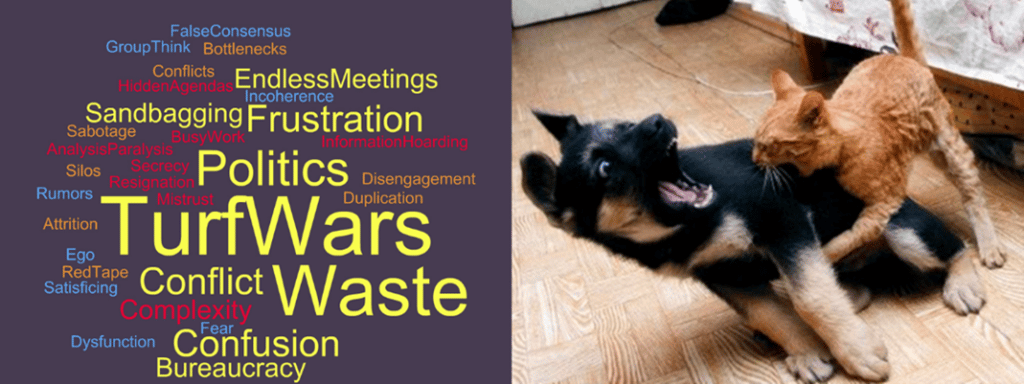
These reasons for misalignment are leadership failures. Most leaders sense alignment is important but don’t know how to do it. They deliver a speech or two about their strategic direction, send messages about working hard or smart, and install an annual performance review system for pay increases, bonuses, or promotions. Then they wonder why departments are working at cross-purposes. They don’t understand why there are turf wars between groups, or why so many people are checked out?

Alignment Scorecard
When organizations aren’t aligned, it can reduce performance dramatically and cause frustration and dysfunction. With this Alignment Scorecard, you can assess your organization’s level of alignment and make plans for improving it.
Our Ten-Step Alignment Model
Here is our ten-step alignment model, based on our own experience working in and with organizations across industries and sectors, starting with the very long-term and ending with the very short-term:
1. Purpose
Purpose addresses why an organization exists. People hunger to know that their efforts are worthwhile. They’d like assurance they’re working on something significant. Ideally, the purpose statement should be very short, inspiring, and memorable so that everyone in the organization knows it. For example, the purpose statement of General Mills is: “To make food the world loves.” Netflix: “To entertain the world.”
Purpose is different from an organization’s mission, which normally describes “what” an organization does with its products and services and sometimes “where” it operates. For example, IKEA’s mission statement is: “To offer a wide range of well-designed, functional home furnishing products at prices so low that as many people as possible will be able to afford them.” Most people can’t remember their organization’s mission statement. If an organization has a mission statement that has served them well, we encourage them to create an inspiring purpose statement as well.
2. Values
Values are the agreed upon shared norms that guide behavior in an organization. The values are the standards the organization sets for how people should behave. Everyone in the organization should know them and be responsible for upholding them. For example, Kellogg’s values are: “Integrity, Accountability, Passion, Humility, Simplicity, Results.” We recommend explaining each value word with a description or explanation of what is meant for greater clarity. An advanced leadership practice is tying each value to clear and measurable behaviors for performance reviews, as at Tyco, Netflix, and Infosys.

Personal Values Exercise
Complete this exercise to identify your personal values. It will help you develop self-awareness, including clarity about what’s most important to you in life and work, and serve as a safe harbor for you to return to when things are tough.
3. Vision
The vision provides a clear and emotionally compelling picture of what an organization aspires to achieve over the medium-term future. The vision should describe what success looks and feels like. We recommend including major stakeholder groups, such as customers, workers, shareholders, and the community, in the vision.
4. Goals
Goals are the objectives the organization wishes to achieve. They’re expressed as end results, not the means of how to achieve them. The best goals are clear, measurable, prioritized, and challenging but achievable. To illustrate, here is a set of hypothetical goals for an organization. Goals in priority order might be:
- By 20XX, achieve customer satisfaction levels of 4.8 (on a 5-point scale).
- By 20XX, achieve worker satisfaction levels of 4.6 (on a 5-point scale).
- By 20XX, earn a return on invested capital of X%.
Each of these goals can have sub-goals, but the top overarching goal by stakeholder group is indicated above, and the tradeoffs between them are clear. If there’s a choice between satisfying the customer or the worker, and no way to satisfy both, then the customer comes first in this example. (See our article, “The Missing Links in Goal-Setting (How to Rock Your Goals).”)
5. Strategy
Strategy is how the organization intends to achieve its goals. The strategy should include the several major initiatives of how to achieve the goals in ways that are different from or executed better than competitors. Everybody in the organization should receive a summary of the strategy. Apple wanted to create a unique brand that people associate with success and prosperity. Their strategy statement was: “stylish design and branding, regular technical updates, creation of a closed ecosystem, nice product packaging.”
6. People
This step specifies the types of people who should work in the organization. It should include the characteristics and diversity of people desired. It should also include the “head” qualities such as the knowledge, skills, and capabilities required as well as the “heart” qualities such as courage, character, passion for the vision, and emotional intelligence.
7. Structure
The structure involves choosing the proper organizational form for the enterprise: business units, functional departments, degree of decentralization, and more. It might specify the optimal number of layers of management there should be. It could also specify the ideal spans of control (the ideal number of direct reports for a manager). Structure should designate what the organization does internally versus contracting externally. Optimally, structure should also include frequent use of temporary, rapid-action teams (e.g., Tiger Teams) for short- and long-term projects. Unlike permanent departments, these teams form around a project and disperse once their task is complete. They offer the organization flexibility in dealing with opportunities and challenges.
8. Processes
These are the necessary processes to guide the organization’s work. They include the standards, systems, and policies codified for efficiency and effectiveness. They might include processes for people (e.g., recruiting and development), accounting and financial controls, product development methods, manufacturing standards, ethics monitoring systems, and more. Processes—when done well—can promote efficiency, transparency, and coordination, if they’re streamlined and not burdensome (e.g., lean startup innovation methods or agile software development).
9. Action Plans
These are the several tactical short-term actions that must be taken at each level to accomplish important, nonroutine tasks. Action plans document who will do what by when. They foster accountability. They are traceable to a schedule, ideally with a budget estimate, and are unique for each person or unit. An example: “Mary will update the product X promotional campaign by September 30, keeping campaign costs to a budget of $Y.” Action plans should always be traceable back to the organization’s overall goals.
10. Communication Loops
Alignment requires tracking and reporting metrics on a regular schedule of reports, meetings, and dashboards of key indicators. The metrics should be clear, simple, accessible, and under the control or substantial influence of the relevant department or person. Using various communication loops showing the relevant metrics, leaders will adjust and pivot their actions to achieve their goals and tactical objectives. An example: “Each division manager will present their dashboard of key metrics to achieve each month in the division managers’ meeting.”
Leaders should tie the metrics to performance appraisals, merit increases, incentive pay, recognition, discipline, and promotions. Such reinforcement is essential for alignment. These metrics reported in their regular communication loops give the alignment practice teeth. Without visibility on metrics and accountability for results, alignment won’t happen.
Each alignment step links with the other steps. The sequence and order are deliberate, moving from the aspirational to the strategic to the execution phase, cascading from the long-term to the short-term. See Figure 1 below.
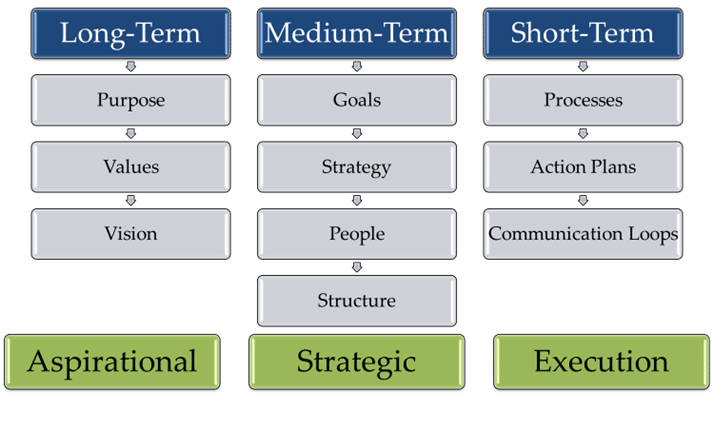
Of course, alignment in and of itself doesn’t magically create success. With a flawed strategy, broken business model, or poor execution, even an aligned organization will falter.
Also, organizations can align toward the wrong things. A company totally aligned on meeting earnings targets each quarter to prop up its share price may very well be cutting corners, destroying long-term shareholder value, and utilizing unsustainable practices. Alignment is successful when it contributes to creating an excellent, ethical, and enduring organization.
The Benefits of Alignment
The benefits of alignment are numerous. For example, alignment:
- clarifies the elements for success
- focuses people
- eliminates waste
- reduces complexity
- connects people and departments
- builds trust
- provides ongoing feedback
- motivates people
- fosters teamwork
- instills discipline
- builds commitment
- unleashes talent
- reinforces the culture
- creates the conditions for flow and peak performance
Alignment in Context
Alignment is the fifth and final practice we cite in our book, Triple Crown Leadership: Building Excellent, Ethical, and Enduring Organizations. These five practices create a high-performing organization on the quest to be excellent, ethical, and enduring.
The five advanced triple crown leadership practices are:
- Head & Heart: Recruit for, develop, and reward character, emotional intelligence, courage, resilience, etc. (heart) as well as knowledge and skills (head).
- The Colors: Collaboratively set an inspiring purpose, values, and vision and then bring them to life to build a culture of character in the organization.
- Steel & Velvet: Get beyond your natural leadership style, flexing between the hard and soft edges, depending on the people and situation, but always anchored in the shared values.
- Stewards: Unleash people to act and lead by the shared values, encouraging them to step outside their functional roles and be stewards of the culture and to take initiative.
- Alignment: Collaboratively align the organization up, down, and around to reach a state of peak performance.
Following from the first four practices, the alignment steps activate the organization’s life force.
Alignment can lead to peak performance.
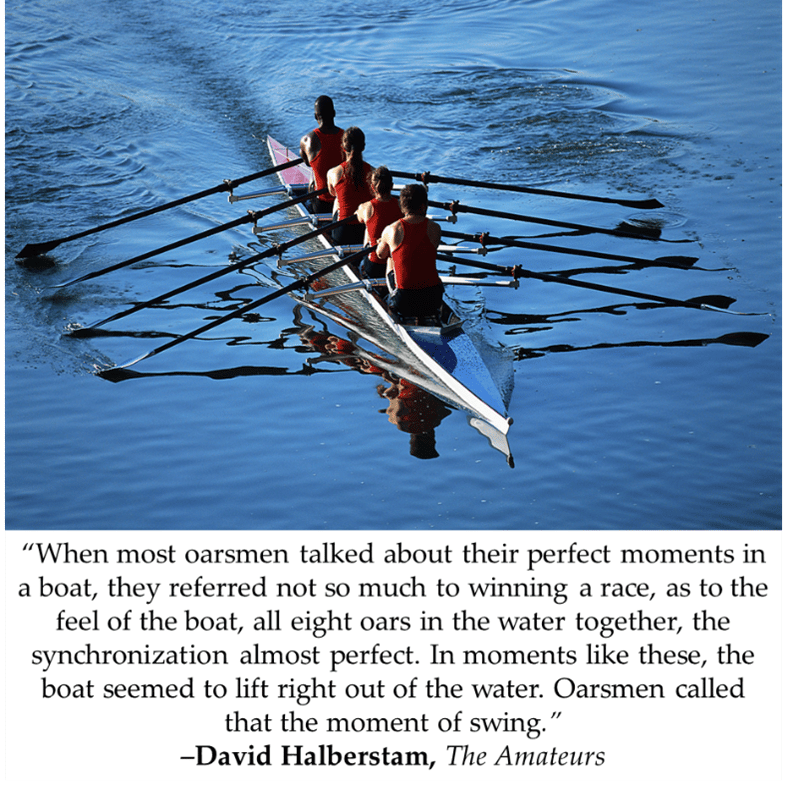
How to Implement the Alignment Model
Where to start? Where to start alignment depends on where the organization is at the time. You can start wherever you are and then circle back to the other steps later.
If the organization is stable but needs to get reenergized or bring disparate elements together, then start with a reexamination of alignment steps 1, 2, and 3: purpose, values, and vision. You might begin with the board and senior management team meeting at some offsite retreats with drafts of their work circulating out for collaborative input.
If the organization needs to submit its strategic plan to the board for approval, it should start with alignment steps 4 and 5: goals and strategy.
If the organization is in crisis, it has no time for offsite retreats to ponder purpose or vision. It must first stop the bleeding with alignment steps 9 and 10: action plans and communication loops.
Alignment requires work at all the levels of an organization and should flow in all directions:
Top-Down Cascades
Some alignment steps must cascade down the organizational hierarchy from the board to the front-line supervisors and workers.
- The CEO and senior management team should take the lead in drafting or redrafting the organization’s purpose, values, and vision. That work takes time and needs to get the input and buy-in of workers and some external stakeholders such as some customers, suppliers, and community leaders. Then the CEO takes the drafts to the board for discussion, collective refinement, and approval. Then they transmit that message to every worker and relevant outside stakeholder.
- The same top-down cascade guides the organization’s goal setting and strategic planning, with the top management team drafting recommendations for the board, refining the recommendations, securing board approval, and then asking progressively lower levels in the hierarchy to draft compatible goals and tactical actions to achieve the overarching goals. This process engenders alignment. Goals and tactical actions outside the strategic goals and initiatives are off limits.
Middle-Level-Out Releases
Some alignment steps find their genesis in emanations from the mid-level managers who frequently create new ideas on alignment steps 6, 7, and 8: the types of people needed, the organization structure, and the processes needed to drive the organization’s activities.
Bottom-Up Percolations
Frequently, the best ideas in alignment steps 9 and 10, action plans and communication loops, originate at the front-line worker and supervisor levels and work their way into the alignment practice by percolating upwards.
Alignment should occur at multiple levels in the organization: enterprise-wide, departmental, team, and individual. Each group can benefit from its own alignment practice, even with its own departmental purpose, values, and vision, if they’re compatible with the organization-wide statements. Everyone’s goals, strategies, and action plans should map to those of the relevant team, and from team to department, all the way up to the top of the organization. See Figure 2.
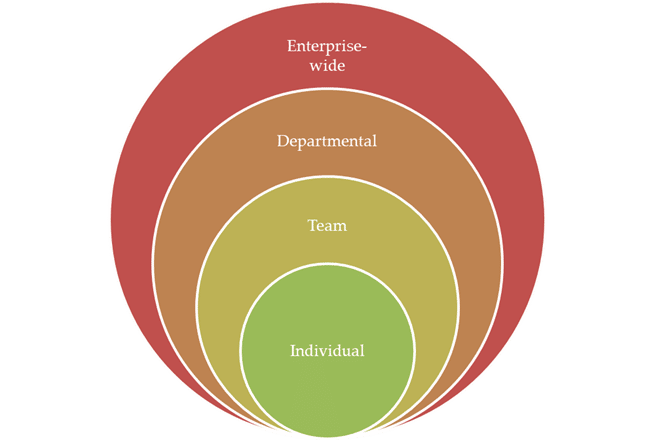
Alignment Is a Collaborative Leadership Practice
Alignment is a collaborative leadership practice, cascading down, spreading outwards, and percolating upwards. This multi-faceted practice brings people into a self-reinforcing configuration using various management and leadership activities.
Alignment requires extensive, multidirectional communication with deep listening and dialogue, not just edicts from the top. Alignment is a back and forth, up, down, and sideways practice that touches everyone in the organization, even some outside stakeholders.
The first time an organization undertakes the alignment practice, it can take some months or even up to a year to move through all the alignment steps, depending on the organization and the severity of its issues. It takes time for ideas to simmer, for feedback to percolate from all parts of the organization, and for consensus and commitment to develop. Alignment is an ongoing practice, not a one-time fix.
Alignment is also a “we” practice, not an “I” practice. Triple crown leadership is a group performance, not a solo act. An autocratic leader may get faster action but will not tap into the commitment and creativity of the people. Alignment takes time and patience. It can be messy and sometimes frustrating, requiring midcourse corrections. But it generates phenomenal results when done well.
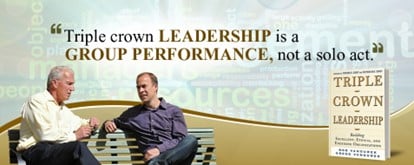
Summary
Alignment is a collaborative leadership practice moving from the long-term of why the organization exists to the short-term of “who will do what by when?” and frequent meetings examining key metrics. Our alignment model includes purpose, values, vision, goals, strategy, people, structure, processes, action plans, and communication loops. Alignment is a powerful way of coalescing people to work together effectively.
Whenever a group of people becomes aligned, the chances for success improve dramatically. Alignment creates multiple, empowered leaders throughout the organization who know what to do and when to do it. The alignment process fosters teamwork and precludes excuses by providing continual, relevant feedback.
Alignment, together with our other four triple crown leadership practices, creates a high-performing organization that’s excellent, ethical, and enduring.
Once you work in an aligned organization, you’ll never want to work anywhere else.
Reflection Questions
- Is your organization aligned?
- If not, are you ready to undertake our alignment process?

Alignment Scorecard
When organizations aren’t aligned, it can reduce performance dramatically and cause frustration and dysfunction. With this Alignment Scorecard, you can assess your organization’s level of alignment and make plans for improving it.
Tools for You
- Leadership Derailers Assessment to help you identify what’s inhibiting your leadership effectiveness
- Personal Values Exercise to help you determine and clarify what’s most important to you
- Alignment Scorecard to help you assess your organization’s level of alignment
Related Articles
Postscript: Quotations on Alignment
- “Building a visionary company requires 1 percent vision and 99 percent alignment…. Creating alignment may be your most important work.” -Jim Collins and Jerry Porras
- “My role is to try to get everyone in the organization aligned.” -Tony Hsieh, former CEO of Zappos
- “Far and away the biggest mistake (leaders) make is ignoring the crucial importance of alignment.” -Jim Collins and Jerry Porras (from Built to Last)
- “An organization can be both values-centered and performance-driven. The key is aligning the organization’s values and performance objectives.” -Bill George, Authentic Leadership
- “Every bird can fly faster in formation than alone.” -Diane Sawyer
Appendix: Other Alignment Models
There are many books and articles about alignment—and alignment frameworks. Most are incomplete or ineffective. In our research on great organizations, including interviews with leaders in 61 organizations in 11 countries, we often heard about their alignment efforts and saw examples of what they were doing. Here are some of the main ones:
- McKinsey’s 7S Framework. A management model that includes strategy, structure, systems, shared values, skills, style, and staff.
- Balanced Scorecard. A strategy performance management tool sometimes used to help align organizations.
- Team Alignment Map. It includes joint objectives, joint commitments, joint resources, and joint risks
- Patrick Lencioni’s Six Critical Questions for Creating Clarity. Why do we exist? How do we behave? What do we do? How will we succeed? What is most important, right now? Who must do what? (from his book, The Advantage).
- Salesforce’s Alignment Model, “V2MOM.” It includes vision, values, methods, obstacles, and measures.
References:
(1) Source: Booz & Company survey of more than 1,800 executives (including more than 480 C-suite respondents) from companies of various sizes and from around the globe and many industries. Their coherence test looks at whether people can state the organization’s strategy and whether the firm lives it across four areas: 1. Way to Play, 2. Capabilities System, 3. Product/Service Fit, 4. Coherence. More coherent firms perform better. See also Paul Leinwand and Cesare Mainardi, “The Coherence Premium,” Harvard Business Review, June 2010. See also: “Coherence Premium” podcast: http://blogs.hbr.org/2011/02/the-coherence-premium/
(2) Source: Sull and Homkes, “Why Strategy Execution Unravels—and What to Do About It,” Harvard Business Review, March 2015. More data from the study: 84% of managers say they can rely on their boss and direct reports all or most of the time; only 9% say they can rely on colleagues in other functions and units all the time; just half say they can rely on them most of the time. Conflicts between functions and units are handled badly two times out of three—resolved after a major delay (38% of the time), resolved quickly but poorly (14%), or left to fester (12%). See also Donald N. Sull and Charles Spinosa, “Promise-Based Management: The Essence of Execution,” Harvard Business Review, April 2007.

Triple Crown Leadership Newsletter
Join our community. Sign up now and get our monthly inspirations (new articles, announcements, opportunities, resources, and more). Welcome!
+++++++++++++++++++++++
Gregg Vanourek and Bob Vanourek are leadership practitioners, teachers, and award-winning authors (and son and father). They are co-authors of Triple Crown Leadership: Building Excellent, Ethical, and Enduring Organizations, a winner of the International Book Awards. Check out their Leadership Derailers Assessment or get their monthly newsletter. If you found value in this, please forward it to a friend. Every little bit helps!


2 thoughts on “How to Align Your Organization for Peak Performance”
Bob and Greg,
I enjoyed your article on alignment. It’s a very important topic.
If you would like an electronic copy of my book, Is Your Organization Aligned, email me and I will send it.
Paul B. Thornton
Hi Paul. Thanks for your kind note and offer. Will be in touch separately. Cheers, Gregg